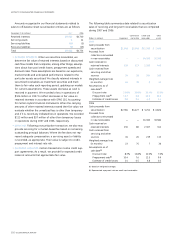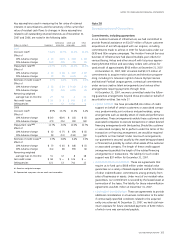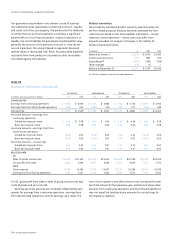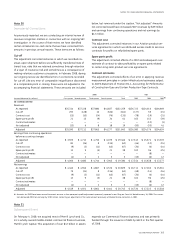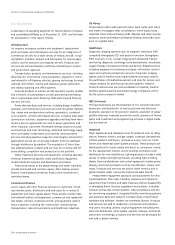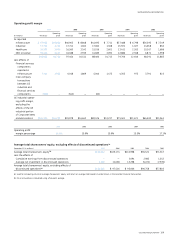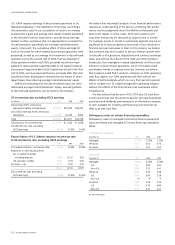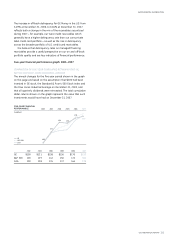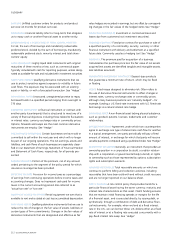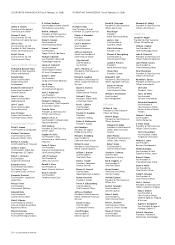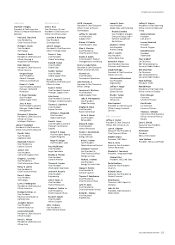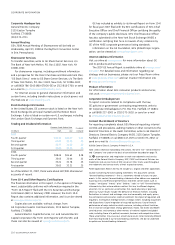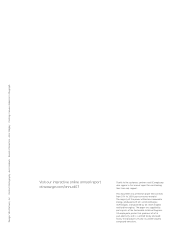GE 2007 Annual Report Download - page 114
Download and view the complete annual report
Please find page 114 of the 2007 GE annual report below. You can navigate through the pages in the report by either clicking on the pages listed below, or by using the keyword search tool below to find specific information within the annual report.112 ge 2007 annual report
BACKLOG Unfi lled customer orders for products and product
services (12 months for product services).
BORROWING Financial liability (short or long-term) that obligates
us to repay cash or another fi nancial asset to another entity.
BORROWINGS AS A PERCENTAGE OF TOTAL CAPITAL INVESTED
For GE, the sum of borrowings and mandatorily redeemable
preferred stock, divided by the sum of borrowings, mandatorily
redeemable preferred stock, minority interest and total share-
owners’ equity.
CASH EQUIVALENTS Highly liquid debt instruments with original
maturities of three months or less, such as commercial paper.
Typically included with cash for reporting purposes, unless desig-
nated as available-for-sale and included with investment securities.
CASH FLOW HEDGES Qualifying derivative instruments that we
use to protect ourselves against exposure to volatility in future
cash fl ows. The exposure may be associated with an existing
asset or liability, or with a forecasted transaction. See “Hedge.”
COMMERCIAL PAPER Unsecured, unregistered promise to repay
borrowed funds in a specifi ed period ranging from overnight to
270 days.
DERIVATIVE INSTRUMENT A fi nancial instrument or contract with
another party (counterparty) that is structured to meet any of a
variety of fi nancial objectives, including those related to fl uctuations
in interest rates, currency exchange rates or commodity prices.
Options, forwards and swaps are the most common derivative
instruments we employ. See “Hedge.”
DISCONTINUED OPERATIONS Certain businesses we have sold or
committed to sell within the next year and which will no longer
be part of our ongoing operations. The net earnings, assets and
liabilities, and cash fl ows of such businesses are separately classi-
fi ed on our Statement of Earnings, Statement of Financial Position
and Statement of Cash Flows, respectively, for all periods pre-
sented.
EARNED PREMIUMS Portion of the premium, net of any amount
ceded, pertaining to the segment of the policy period for which
insurance coverage has been provided.
EFFECTIVE TAX RATE Provision for income taxes as a percentage
of earnings from continuing operations before income taxes and
accounting changes. Does not represent cash paid for income
taxes in the current accounting period. Also referred to as
“actual tax rate” or “tax rate.”
EQUIPMENT LEASED TO OTHERS Rental equipment we own that is
available to rent and is stated at cost less accumulated depreciation.
FAIR VALUE HEDGE Qualifying derivative instruments that we use to
reduce the risk of changes in the fair value of assets, liabilities or
certain types of fi rm commitments. Changes in the fair values of
derivative instruments that are designated and effective as fair
value hedges are recorded in earnings, but are offset by correspond-
ing changes in the fair values of the hedged items. See “Hedge.”
FINANCING RECEIVABLES Investment in contractual loans and
leases due from customers (not investment securities).
FORWARD CONTRACT Fixed price contract for purchase or sale of
a specifi ed quantity of a commodity, security, currency or other
fi nancial instrument with delivery and settlement at a specifi ed
future date. Commonly used as a hedging tool. See “Hedge.”
GOODWILL The premium paid for acquisition of a business.
Calculated as the purchase price less the fair value of net assets
acquired (net assets are identifi ed tangible and intangible assets,
less liabilities assumed).
GUARANTEED INVESTMENT CONTRACTS Deposit-type products
that guarantee a minimum rate of return, which may be fi xed
or fl oating.
HEDGE A technique designed to eliminate risk. Often refers to
the use of derivative fi nancial instruments to offset changes in
interest rates, currency exchange rates or commodity prices,
although many business positions are “naturally hedged” — for
example, funding a U.S. fi xed-rate investment with U.S. fi xed-rate
borrowings is a natural interest rate hedge.
INTANGIBLE ASSET A non-fi nancial asset lacking physical substance,
such as goodwill, patents, licenses, trademarks and customer
relationships.
INTEREST RATE SWAP Agreement under which two counterparties
agree to exchange one type of interest rate cash fl ow for another.
In a typical arrangement, one party periodically will pay a fi xed
amount of interest, in exchange for which that party will receive
variable payments computed using a published index. See “Hedge.”
INVESTMENT SECURITIES Generally, an instrument that provides an
ownership position in a corporation (a stock), a creditor relation-
ship with a corporation or governmental body (a bond), or rights
to ownership such as those represented by options, subscription
rights and subscription warrants.
MANAGED RECEIVABLES Total receivable amounts on which we
continue to perform billing and collection activities, including
receivables that have been sold with and without credit recourse
and are no longer reported on our balance sheet.
MATCH FUNDING A risk control policy that provides funds for a
particular fi nancial asset having the same currency, maturity and
interest rate characteristics as that asset. Match funding ensures
that we maintain initial fi nancing spreads or margins for the life
of a fi nancial asset, and is executed directly, by issuing debt, or
synthetically, through a combination of debt and derivative fi nan-
cial instruments. For example, when we lend at a fi xed interest
rate in the U.S., we can borrow those U.S. dollars either at a fi xed
rate of interest or at a fl oating rate executed concurrently with a
pay-fi xed interest rate swap. See “Hedge.”


